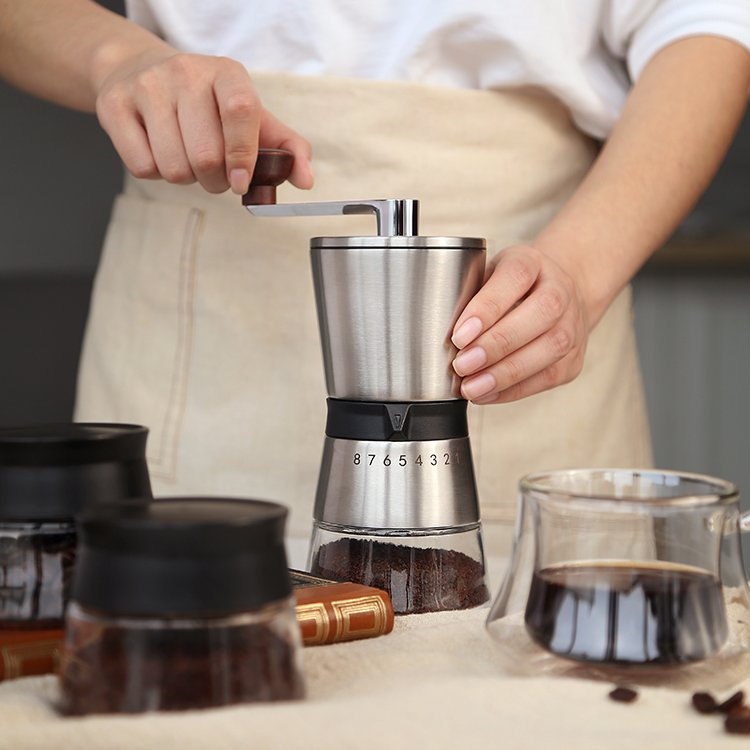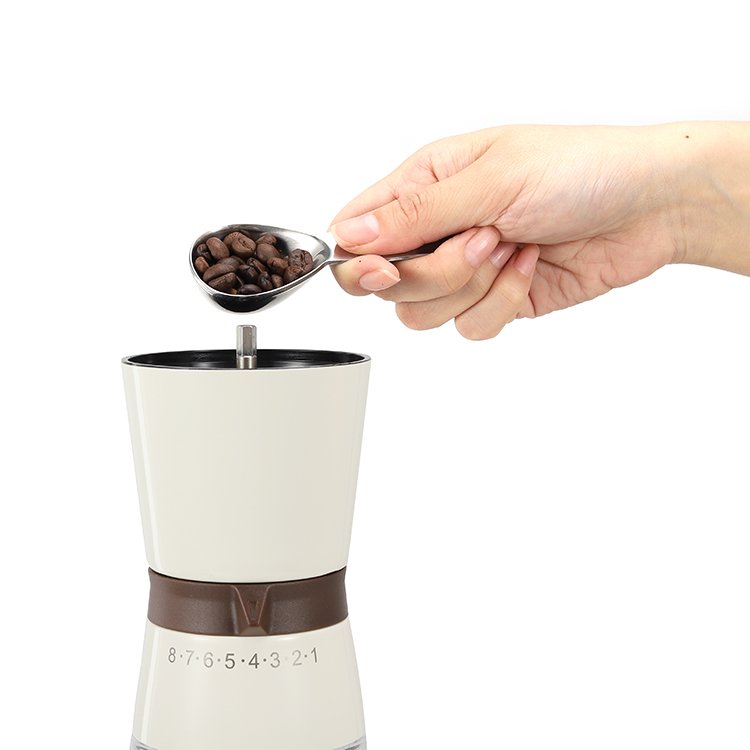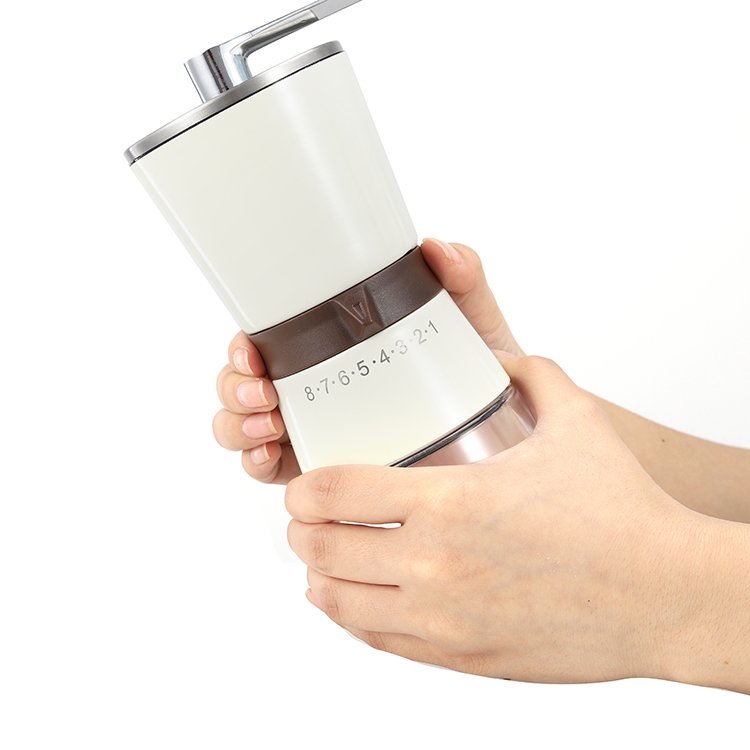
Choosing the right hand grinder for coffee beans shapes your brewing routine. Many coffee lovers prefer a manual coffee burr grinder or a portable coffee grinder for fresher flavor and better control. The table below shows how your needs and taste connect with the coffee grinder you use:
| Trend Description | Impact on Brewing Experience |
|---|---|
| Preference for manual grinding | Greater control over grind size enhances flavor |
| Consistency in grind quality | Improves overall quality of brewed coffee |
| Ritualistic aspect of grinding | Adds enjoyment to coffee preparation |
| Sustainability concerns | Appeals to environmentally conscious consumers |
You can select a hand grinder that fits your needs and enjoy a better cup every day.
Why Grind Quality and Consistency Matter in Coffee Grinders
Impact on Coffee Flavor
When you grind coffee beans, you shape the flavor in every cup. Grind consistency plays a big role in how your coffee tastes. Uniform particle sizes help you get a balanced extraction, which means you enjoy a richer flavor and more clarity in your brew. Scientific studies show that when you use a grinder that delivers even particles, you unlock more aroma and flavor concentration. If your grind is uneven, you might notice muddled taste or a lack of clarity in your cup. Medium-coarse grinds, for example, often bring out sweetness and fruity notes, especially in cold brew. You can taste the difference when your grinder delivers high grind quality and consistency.
Tip: For the best flavor and clarity, always aim for a grinder that produces even grounds.
Extraction and Brew Strength
Grind consistency also affects how strong and clear your brew becomes. Finer grinds have more surface area, so water extracts flavor faster. Coarser grinds need more time, but they can highlight different taste notes. If you use the right grind size, you avoid sour or bitter flavors and get a balanced brew. Here’s how grind consistency influences your coffee:
- Surface area: Finer grinds increase extraction rate.
- Extraction time: Coarser grinds require longer brewing.
- Flavor balance: The right grind size gives you clarity and prevents over- or under-extraction.
You control the clarity and strength of your brew by choosing the right grinder. Consistent grounds help you achieve the taste and quality you want in every cup.
Types of Hand Grinder for Coffee Beans

Burr Grinders
When you want the best flavor from your coffee beans, burr grinders stand out. These coffee grinders use two abrasive surfaces, called burrs, to crush beans into even particles. You get a consistent grind size, which helps you brew better coffee every time. Burr grinders also generate less heat, so your coffee keeps its natural flavors. You can adjust the grind size for different brewing methods, making them a top choice for hand grinders for espresso.
Tip: Consistent grind size leads to better flavor extraction and a smoother cup.
| Feature | Burr Grinder | Blade Grinder |
|---|---|---|
| Grind Consistency | Produces uniform size by crushing beans | Creates uneven sizes, leading to inconsistent grind |
| Heat Generation | Generates less heat, preserving flavor | Generates more heat, potentially making coffee bitter |
| Control | Adjustable grind size for precision | Limited control over grind size |
| Durability | Generally more durable | Typically less durable |
| Overall Coffee Quality | Superior flavor extraction due to uniformity | Inferior flavor due to uneven particle size |
Blade Grinders
Blade grinders use spinning blades to chop coffee beans. You may find these coffee grinders easy to use and affordable. However, they often create uneven grind sizes. This can lead to inconsistent flavor in your cup. Blade grinders also generate more heat, which can affect the taste of your coffee. If you want more control and better results, a hand grinder with burrs is usually a better choice.
- Blade grinders can make coffee taste bitter due to heat.
- Inconsistent grind size can cause uneven extraction.
Ceramic vs. Steel Burrs
When you choose a hand grinder, you often pick between ceramic and steel burrs. Each type has unique benefits.
| Type | Advantages | Disadvantages |
|---|---|---|
| Stainless Steel | Durable and robust construction | May wear down over time |
| Generally more affordable | ||
| Reliable performance for a significant period | ||
| Ceramic | Holds sharpness longer for consistent grind | More prone to cracking or breaking |
| Generates less heat, preserving coffee flavors |
Ceramic burrs stay sharp longer and keep your coffee cool during grinding. Steel burrs offer strength and reliability. Both options help you get the most from your hand grinder.
Matching Grind Size to Brewing Method with a Manual Coffee Grinder

Grind Size Chart for Popular Brewing Methods
Choosing the right grind size helps you get the best flavor from your coffee. Each brew method works best with a specific grind size. Use this chart to guide your manual coffee grinder adjustments:
| Brewing Method | Recommended Grind Size (Microns) |
|---|---|
| French Press | 60-70 |
| Pour Over | 45-65 |
| Espresso | 10-20 |
A coarse grind suits French press because it allows water to flow slowly and extract flavor gently. Pour over needs a medium grind for balanced extraction. Espresso requires a fine grind to brew quickly and create a strong, rich shot.
Tip: Adjust your grinder settings before each brew to match your chosen method.
Why the Right Grind Size Matters
You control the taste and strength of your coffee by choosing the correct grind size. Different brew methods need different grind sizes to avoid sour or bitter flavors.
- Finer grinds work best for quick brew methods like espresso. They help you extract enough flavor in a short time.
- Coarser grinds fit longer brew methods such as French press. They prevent over-extraction and bitterness.
- If you use a grind that is too coarse, your brew may taste weak or sour.
- If you use a grind that is too fine, your brew can become bitter and harsh.
- The right grind size lets you balance aroma, flavor, and strength in every brew.
You can experiment with your manual coffee grinder to find the perfect grind for each brew. This small change can make a big difference in your daily coffee experience.
Step-by-Step Guide to Choosing a Hand Grinder for Coffee Beans
Burr Type and Material
When you select a hand grinder for coffee beans, you need to focus on the burr type and material. Burrs are the parts that crush and grind your beans. The two main types are conical and flat burrs. Each type affects your brew in different ways. The table below shows how they compare:
| Feature | Conical Burrs | Flat Burrs |
|---|---|---|
| Design | Cone inside a ring | Two parallel rings |
| Noise Level | Quieter | Louder |
| Grinding Speed | Slower | Faster |
| Heat Generation | Lower | Higher |
| Best For | All-purpose brewing | Espresso focus |
| Price Range | Generally lower | Typically higher |
You also need to consider the material. Steel burrs work well for daily use because they are efficient and durable. Ceramic burrs stay sharp longer and keep your coffee cool during grinding. However, ceramic burrs can be more expensive and fragile. If you want a hand grinder for coffee beans that lasts, look for high-quality materials like stainless steel or advanced ceramics.
Tip: Choose a burr type and material that matches your brew style and daily needs.
Grind Settings and Adjustability
Grind settings play a big role in how your coffee tastes. You want a manual coffee grinder that lets you adjust the grind size easily. This feature helps you match your grind to your brew method, whether you use French press, pour over, or espresso. Many of the best manual coffee grinder models offer a wide range of settings. For example, the Timemore C3 has precise adjustments for different brew styles. The M47 Simplicity uses a 47mm stainless steel conical burr for consistent grind quality.
If you want to know what to look for in a manual coffee grinder, always check the adjustability. Models with easy-to-use dials or numbered settings make your brewing routine smoother. User reviews show that grinders with simple adjustment systems, like a plastic nut or a clear dial, improve your experience and help you get the right grind every time.
Capacity and Size
Capacity affects how much coffee you can grind at once. If you brew single cups, a smaller hand grinder for coffee beans works well. The Timemore Chestnut C3 holds about 25 grams, which is perfect for one cup. If you brew for a group, you may want a larger grinder. The Comandante can hold up to 40 grams and even comes with a second jar for bulk grinding.
- The Timemore Chestnut C3 is ideal for single servings.
- The Comandante suits larger brews and group settings.
Size also matters for storage and travel. Compact grinders fit easily in your bag or kitchen drawer. If you want a hand grinder that travels well, look for a model with a slim profile and lightweight build.
Portability and Ease of Use
If you travel or like to brew coffee outdoors, portability becomes important. You want a hand grinder for coffee beans that is compact and light. Here are the most important factors for portability and ease of use:
- Size and Weight: Choose a grinder that is easy to carry and does not take up much space.
- Ease of Use: Look for features like a comfortable handle and simple grind adjustments.
- Grind Settings: Multiple settings let you customize your brew, making the grinder more versatile.
Some coffee grinders, like the Timemore C3, are designed for travel and easy handling. The M47 Simplicity, with its solid stainless steel body, offers stability but may be heavier. User reviews often mention that grinders with ergonomic handles and non-slip exteriors make grinding easier, especially by hand.
Price and Value
Price is a key factor when you choose a hand grinder for coffee beans. Lower-priced grinders may seem attractive, but they often lack grind consistency and quality of materials. This can affect your brew and overall coffee experience. Higher-priced grinders use better materials and provide more consistent grind quality. For example, the Hario Skerton, priced at $55, has issues with burr stabilization and grind consistency. The Timemore Chestnut C3, starting at $79, offers solid construction and better grind quality.
- Lower-priced grinders may not deliver the quality you want.
- Higher-priced models often use high-quality materials and offer better performance.
- The best options balance price and value, giving you reliable results for every brew.
When you invest in a manual coffee grinder, you want value for your money. Look for a model that matches your brewing needs, uses durable materials, and fits your budget. This way, you enjoy great coffee and long-lasting quality.
Practical Tips for Best Results with Manual Coffee Grinder
Cleaning and Maintenance
You want your manual coffee grinder to deliver fresh flavor and reliable results every time you brew. Regular cleaning keeps your hand grinder working smoothly and preserves grind consistency.
- Disassemble your grinder often to clean key parts.
- Use a small brush to remove coffee residue from tight spaces.
- Empty the grind chamber after each brew to prevent stale odors.
- Wipe down surfaces with a dry cloth to reduce oil buildup and keep your grinder fresh.
- Deep clean every month by washing removable parts and letting them dry completely.
Check the table below for recommended maintenance intervals to keep your hand grinder in top shape:
| Timeframe | Maintenance Task | Time Required | Focus Areas |
|---|---|---|---|
| After each use | Quick clean | 30 seconds | Empty grounds, brush visible areas |
| Weekly | Basic cleaning | 5-10 minutes | Partial disassembly, accessible burrs |
| Monthly/5 lbs coffee | Deep clean | 30 minutes | Full disassembly, all components |
| Quarterly | Inspection | 30-45 minutes | Deep clean plus parts inspection |
| Annually | Performance check | 60 minutes | Deep clean plus calibration |
Getting Consistent Grinds
You can achieve consistent grind results with a few simple techniques.
Regular cleaning of the burrs is essential to maintain their performance and ensure a consistent grind. Disassemble the grinder carefully to access the burrs and use a soft brush to remove accumulated particles.
Follow these steps for better grind consistency and brew quality:
- Adjust the grind size using the step dial on your manual coffee grinder. Turn clockwise for finer grinds and counterclockwise for coarser grinds.
- Clean the burrs regularly to prevent oil and particle buildup.
- Grind at a steady speed to get uniform results and fresh ground coffee.
- Place a towel under your hand grinder to absorb vibrations and improve stability.
You will notice fresher taste, better brew results, and improved grind consistency when you care for your manual coffee grinder and use these tips.
Common Mistakes to Avoid When Buying Coffee Grinders
Overlooking Grind Settings
You might feel tempted to pick up the first hand grinder you see, but ignoring grind settings can lead to disappointing results. Many people do not realize how much grind size affects the taste of their brew. If you use grounds that are too coarse, your coffee can taste weak or even sour. On the other hand, if you grind too fine, your brew may become bitter and harsh. The right grind setting helps you reach optimal extraction, giving you a balanced and flavorful cup every time.
Tip: Adjust your grinder for each brew method. This small step can make a big difference in flavor.
Common mistakes include:
- Using entry level coffee grinders without adjustable settings.
- Sticking with pre-ground coffee because you feel unsure about grinder options.
- Fearing to adjust the grinder, which leads to the same grind for every brew.
You should always match your grind size to your brew method for the best results.
Ignoring Build Quality
Build quality plays a huge role in how your hand grinder performs and lasts. Some coffee grinders use cheaper parts, which can affect grind quality and consistency. For example, grinders with poor burr stabilization may not deliver even grounds, making your brew unpredictable. Manual grinders made with high-quality materials often last longer and provide better results.
- High-quality hand grinders offer better durability and grind quality.
- Cheaper grinders may wear out quickly and struggle to produce consistent grounds.
- Manual grinders usually outperform electric models in terms of longevity and quality.
When you choose a hand grinder, pay attention to the materials and construction. A well-built grinder ensures you enjoy a great brew for years.
Choosing a hand grinder that matches your brew style and lifestyle helps you unlock a richer coffee experience. Consider grind consistency, ease of use, and portability. When you select the right grinder, you gain control over every brew. Start your journey and enjoy fresh flavors in every cup.
FAQ
How often should you clean your hand coffee grinder?
Clean your grinder after every use for the best flavor. Deep clean it once a month to keep it working smoothly and prevent stale tastes.
Can you use a hand grinder for both espresso and French press?
You can use a hand grinder for both. Adjust the grind size for each method. Fine for espresso, coarse for French press.
What is the best way to store your manual coffee grinder?
Store your grinder in a dry place. Keep it away from moisture and direct sunlight. This helps protect the burrs and keeps your grinder in top condition.






